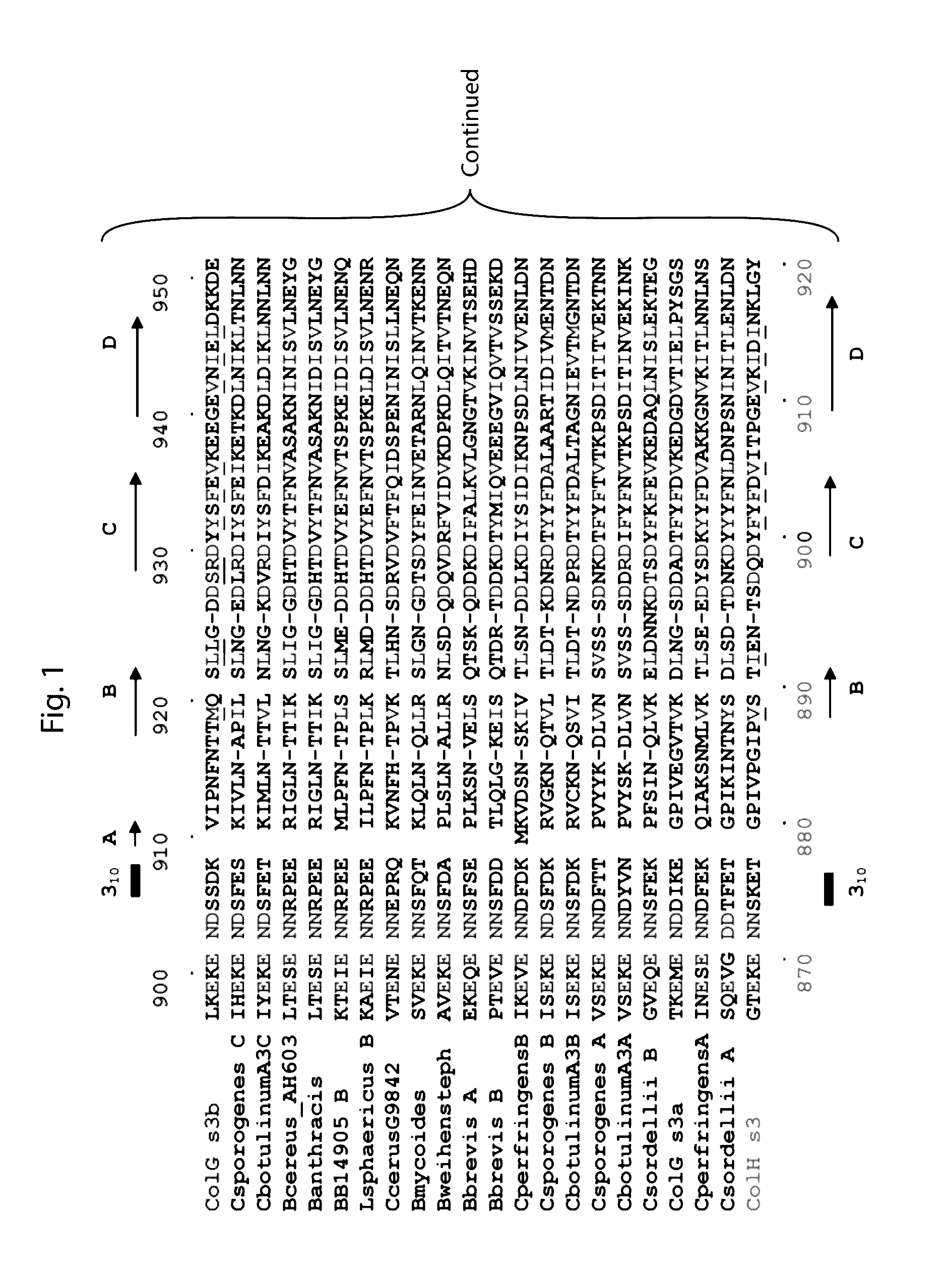Delivery of therapeutic agents by a collagen binding protein
a technology of collagen binding protein and therapeutic agent, which is applied in the direction of antibody mimetics/scaffolds, peptide/protein ingredients, fusion polypeptides, etc., can solve the problems of reducing self-esteem, depression, reducing well-being, etc., and achieves the effect of increasing hair growth or speeding up hair regrowth
- Summary
- Abstract
- Description
- Claims
- Application Information
AI Technical Summary
Benefits of technology
Problems solved by technology
Method used
Image
Examples
example 1
CBD Targets Partially Untwisted or Undertwisted Regions of Collagen
[0076]Clostridium histolyticum collagenase causes extensive degradation of collagen in the connective tissue resulting in gas gangrene. The C-terminal collagen-binding domain (CBD) of these enzymes is the minimal segment required to bind to the collagen fibril. CBD binds unidirectionally to the partially untwisted C-terminus of triple helical collagen. Whether CBD could also target under-twisted regions even in the middle of the collagen triple helix was examined. Partially untwisted collageneous peptides were synthesized by introducing a Gly→Ala substitutions into the collagen ([(POG)xPOA(POG)y]3 where x+y=9 and x>3). 1H-15N heteronuclear single quantum coherence nuclear magnetic resonance (HSQC NMR) titration studies with 15N-labeled CBD demonstrated that the untwisted mini-collagen binds to a 10 Å wide 25 Å long cleft. Six untwisted collagenous peptides each labeled with a nitroxide radical were then titrated with...
example 2
Structural Comparison of ColH and ColG Collagen-Binding Domains
[0102]The C-terminal collagen-binding domain (CBD) of collagenase is required for insoluble collagen fibril binding and for subsequent collagenolysis. The high resolution crystal structures of ColG-CBD (s3b) and ColH-CBD (s3) the molecules resemble one another closely (r.m.s.d. Cα=1.5 Å), despite sharing only 30% sequence identity. Five out of six residues chelating Ca2+ are conserved. The dual Ca2+ binding sites in s3 are completed by a functionally equivalent aspartate. The three most critical residues for collagen interaction in s3b are conserved in s3. The general shape of the binding pocket is retained by altered loop structures and side-chain positions. Small angle X-ray scattering data revealed that s3 also binds asymmetrically to mini-collagen. Besides the calcium-binding sites and the collagen-binding pocket, architecturally important hydrophobic residues and hydrogen-bonding network around the cis-peptide bond ...
example 3
CBD-PTH Agonist Spurs Hair Growth and CBD-PTH Antagonist Inhibits Hair Growth
[0111]In-Vitro Characterization of CBD-Linked PTH Compounds: Collagen binding of each peptide was verified in flow-through collagen binding assays as previously described in U.S. Patent Publication No. 2010 / 0129341, which is incorporated herein by reference in its entirety. PTH-CBD, consisting of the first 33 amino acids of PTH linked directly to the collagen binding domain (SEQ ID NO: 1), was the most potent agonist, having a similar effect to that of PTH(1-34) (SEQ ID NO: 7) on cAMP accumulation. Ponnapakkam et al. (2011) Calcif 88:511-520. Epub 2011 April 2022. Among the antagonists, PTH(7-33)-CBD (SEQ ID NO: 10) had the best combination of low intrinsic activity and high receptor blockade (not shown), similar to those seen in other PTH antagonists, including those used in hair growth studies. Peters, et al. (2001) J Invest Dermatol 117:173-178.
[0112]In-Vivo Distribution of PTH-CBD: Tissue distribution w...
PUM
| Property | Measurement | Unit |
|---|---|---|
| pH | aaaaa | aaaaa |
| pH | aaaaa | aaaaa |
| pH | aaaaa | aaaaa |
Abstract
Description
Claims
Application Information
 Login to View More
Login to View More - R&D
- Intellectual Property
- Life Sciences
- Materials
- Tech Scout
- Unparalleled Data Quality
- Higher Quality Content
- 60% Fewer Hallucinations
Browse by: Latest US Patents, China's latest patents, Technical Efficacy Thesaurus, Application Domain, Technology Topic, Popular Technical Reports.
© 2025 PatSnap. All rights reserved.Legal|Privacy policy|Modern Slavery Act Transparency Statement|Sitemap|About US| Contact US: help@patsnap.com



